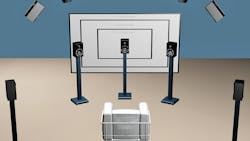Clever Engineering Sends Data Stream Through Audio Paths
Today’s TV facilities use the HD-SDI serial interface standard to transport audio and video signals. It was not designed to carry data channels. During the transition to HDTV decades ago, several schemes were used to send auxiliary data, such as time code signals, audio metadata, or compressed audio bitstreams, in spare sections of the serial-digital-interface (SDI) bitstream.
The most straightforward is to use a pair of PCM audio channels as a 1.5-MB/s data channel. However, transmission equipment may change the gain of the channels to correct loudness or resample them to correct time-base errors. This is transparent to audio signals, but destroys the data. It’s possible to remove most sources of gain changes or resampling, but all equipment in the signal path must be programmed so that it doesn’t perform such operations on those channels only. Furthermore, it must be operationally verified and maintained forever.
The MPEG-HAA system (see "MPEG-H Audio Brings New Features to TV and Streaming Sound") avoids this by encoding the metadata as an audio signal, so it may be resampled or scaled without destroying the data payload. The metadata signal can even be edited along with the content’s audio tracks in an audio- or video-editing program without damaging the metadata.
About the Author
Robert Bleidt
Division General Manager
Robert Bleidt, Division General Manager of Fraunhofer USA Digital Media Technologies, is the inventor of the award-winning Sonnox/Fraunhofer codec plug-in, widely used in music mastering. He led the extension of Fraunhofer’s codec business to an open-source model with its inclusion in Android, and developed Fraunhofer’s Symphoria automotive audio business.
Before joining Fraunhofer, he was president of Streamcrest Associates, a product and business strategy consulting firm in new media technologies. Previously, he was Director of Product Management and Business Strategy for the MPEG-4 business of Philips Digital Networks and managed the development of Philips’ Emmy-winning asset management system for television broadcasting.
Prior to joining Philips, Mr. Bleidt served as Director of Marketing and New Business Development for Sarnoff Real Time Corp., a video-on-demand venture of Sarnoff Labs. Before that, he was Director of Mass Storage Technology and inventor of SRTC's Carousel algorithm.
